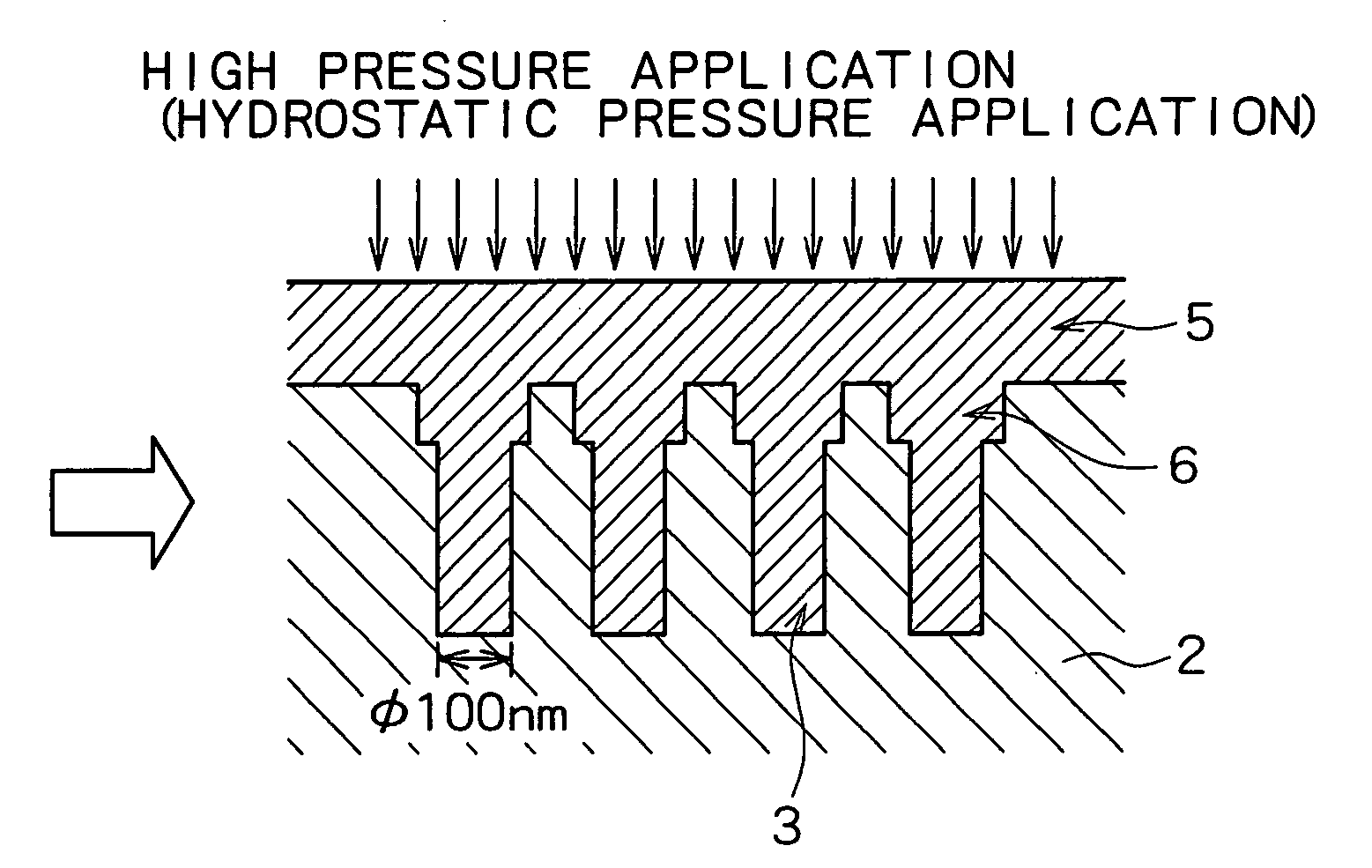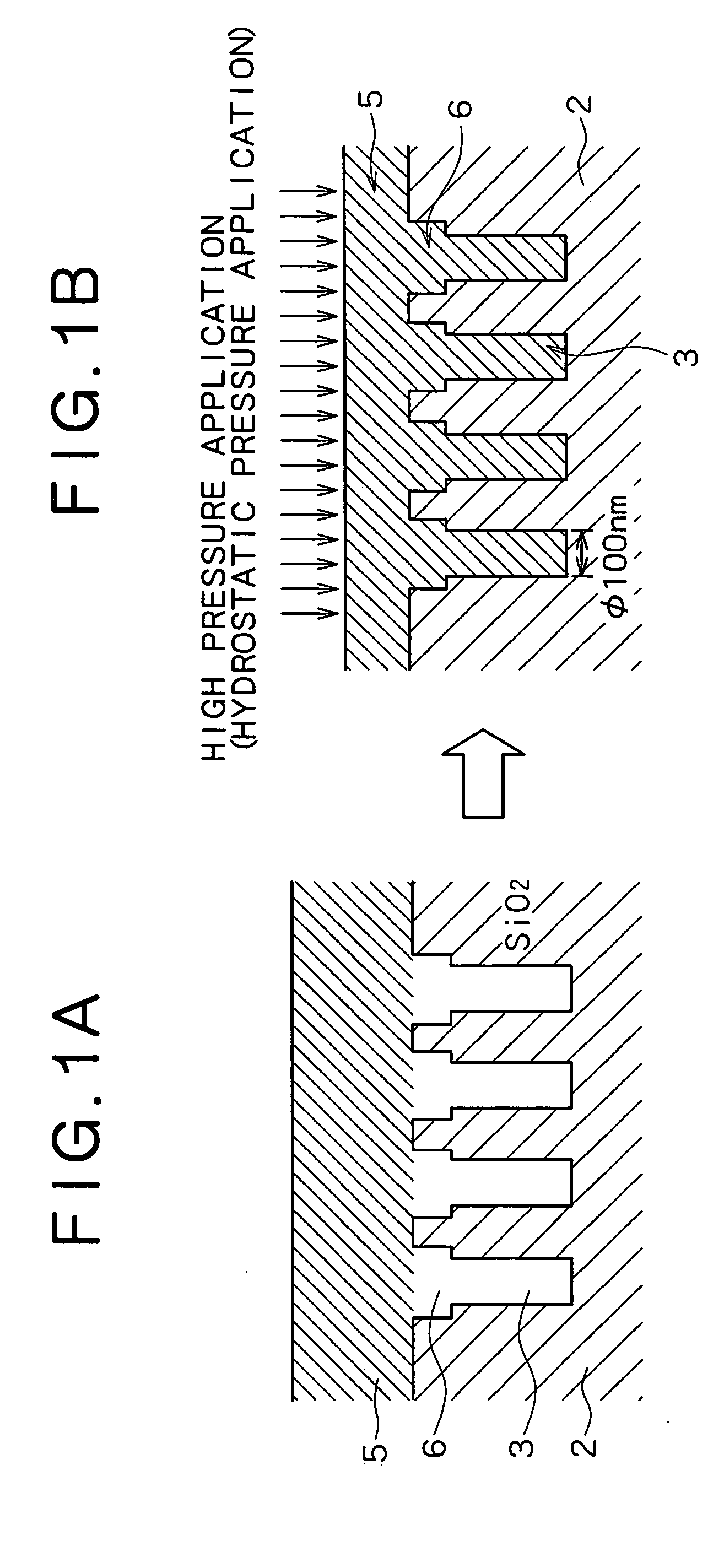Method for fabricating copper-based interconnections for semiconductor device
- Summary
- Abstract
- Description
- Claims
- Application Information
AI Technical Summary
Benefits of technology
Problems solved by technology
Method used
Image
Examples
example 1
[0064] Interconnects were formed in a semiconductor device sequentially in accordance with the processes shown in the schematic sectional views of FIGS. 2A, 2B, 2C and 2D. Specifically, a large number of via hole 3 having a diameter of 0.18 μm and a pitch of 450 nm was formed on a dielectric film (TEOS film: SiOF film) 2 which had been deposited on an 8-inch silicon wafer 1 to thereby yield a test element group (TEG) (FIG. 2A). In this connection, only one via hole 3 is illustrated in FIG. 2A. A thin film of TaN was deposited on a surface of TEG by reactive sputtering in an atmosphere of Ar and N2 gas to thereby deposit a barrier layer (TaN thin film) 4 having a thickness of 50 nm on the bottom and side of the via hole 3 (FIG. 2B).
[0065] Next, a pure Cu thin film 5 having a thickness of 7500 angstroms was deposited on the TEG by sputtering in an atmosphere of Ar gas or in an atmosphere of a gaseous mixture of Ar and H2 so that an opening of the via hole 3 was fully bridged by the C...
example 2
[0074] A barrier layer (TaN thin film) 4 having a thickness of 50 nm was deposited on the bottom and side of a via hole 3 of a TEG by the procedure of Example 1, and a pure Cu thin film 5 having a thickness of 7500 angstroms was deposited thereon by sputtering so that the Cu thin film 5 fully bridged the opening of the via hole 3. The Cu thin film 5 was deposited at the following constant sputtering gas pressure and discharge power density using the following sputtering gas while varying the substrate temperature in a range from −25° C. to 200° C. [0075] Sputtering gas pressure: 2×10−3 Torr [0076] Sputtering gas: Ar−20% H2 [0077] Discharge power density: 3.5 W / cm2
[0078] Next, the TEG was subjected to high temperature and high pressure treatment by the procedure of Example 1, and how Cu was embedded in the via hole 3 was determined. The results are shown in FIG. 4. FIG. 4 is a graph showing the relationship between the filling percentage of Cu and the substrate temperature in deposi...
example 3
[0079] A barrier layer (TaN thin film) 4 having a thickness of 50 nm was deposited on the bottom and side of a via hole 3 of a TEG by the procedure of Example 1, and a pure Cu thin film 5 having a thickness of 7500 angstroms or a Cu alloy thin film 5 having a thickness of 7500 angstroms was deposited thereon by sputtering so that the thin film 5 fully bridged the opening of the via hole 3. In this procedure, the pure Cu thin film 5 was deposited with a pure Cu target, and the Cu alloy thin film 5 was deposited with a Cu alloy target containing 2.0 atomic percent of Dy. The sputtering gas pressure, type of sputtering gas, discharge power density and substrate temperature are as shown in Table 1 (Deposition Condition 1 or Deposition Condition 2).
TABLE 1Deposition parameterCondition 1Condition 2Sputtering gas pressure (Torr)2 × 10−32 × 10−3Type of sputtering gaspure ArAr-20% H2Discharge power density (W / cm2)3.53.5Substrate temperature (° C.)room temperature−20
[0080] The TEG was then ...
PUM
 Login to View More
Login to View More Abstract
Description
Claims
Application Information
 Login to View More
Login to View More - R&D
- Intellectual Property
- Life Sciences
- Materials
- Tech Scout
- Unparalleled Data Quality
- Higher Quality Content
- 60% Fewer Hallucinations
Browse by: Latest US Patents, China's latest patents, Technical Efficacy Thesaurus, Application Domain, Technology Topic, Popular Technical Reports.
© 2025 PatSnap. All rights reserved.Legal|Privacy policy|Modern Slavery Act Transparency Statement|Sitemap|About US| Contact US: help@patsnap.com



